|
|
|
Sort Order |
|
|
|
Items / Page
|
|
|
|
|
|
|
| Srl | Item |
| 1 |
ID:
182858
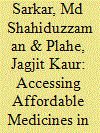

|
|
|
|
|
| Summary/Abstract |
The cost of medicines in Bangladesh is among the lowest in the world. Over the last forty years, Bangladesh, a Least Developed Country (LDC), has nurtured a local industry based on strong industrial policy and a pharmaceutical patent-free system. Of the 46 LDCs in the world, it is the only one to have a thriving industry of this kind. In this paper, we explore how a relatively poor LDC managed to take on the dominance of MNCs in the global production of pharmaceuticals. We focus on the 1982 National Drug Policy (NDP) which transformed the pharmaceutical sector in Bangladesh from one in which three-quarters of drugs were supplied by just eight MNCs to one where almost all domestic demand is met by local industry. The thriving local pharmaceutical industry also exports generic medicines to 147 different countries. In 2026, Bangladesh is due to graduate to ‘Developing Country’ status, at which time, as a member of the WTO, Bangladesh will have to abide by the Trade-Related Aspects of Intellectual Property Rights (TRIPS) Agreement. Under TRIPS it will have to change its patent regime to allow for the registration of pharmaceutical patents by 2029. Using interview data with key Bangladeshi experts, we argue that TRIPS compliance could potentially wipe out this flourishing local pharmaceutical industry, leading to steep increases in the cost of essential medicines, with dire implications for the right to health. We explore policy options open to the Bangladesh government to protect affordable drugs in the country, in particular protection for the production of domestic generics in a post-TRIPS environment. We also argue that there are ways in which Bangladesh and India could co-operate to protect the affordability of high-quality medicines for domestic and international markets.
|
|
|
|
|
|
|
|
|
|
|
|
|
|
|
|
| 2 |
ID:
182856
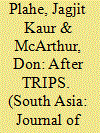

|
|
|
|
|
| Summary/Abstract |
India has long played a key role in supplying low-cost pharmaceuticals to people in developing countries, gaining a reputation as ‘the pharmacy of the developing world’. Yet, changes to India’s intellectual property regime under the World Trade Organization’s 1995 Trade Related Aspects of Intellectual Property Rights (TRIPS) Agreement mean that India’s capacity to produce and supply affordable medicines has been undermined. We use a political economy approach to investigate the factors that are determining the future of Indian generic pharmaceutical companies as suppliers of affordable medicines in the ‘post-TRIPS’ environment. We argue that while there is some scope within this environment for legal safeguards to protect access to life-saving medicines, the future of the ‘pharmacy of the developing world’ is in question, not just because of the ownership rights awarded to multinational corporations (MNCs) under the TRIPS framework, but also because of the way the market system is tilted towards MNCs. MNCs can ‘play’ the system locally and across the world, including by exerting pressure on safeguards that India instituted to protect the affordability of medicines. Against this background, we explore the challenges faced by the Indian government in creating an environment that is more likely to ensure access to life-saving medicines.
|
|
|
|
|
|
|
|
|
|
|
|
|
|
|
|
| 3 |
ID:
182854
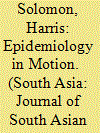

|
|
|
|
|
| Summary/Abstract |
This paper is an ethnographic account of traumatic brain injuries (TBIs) based on a study of a public hospital trauma ward in urban India. It explores the contexts, causes and consequences of TBIs in order to make several broader claims. Across two case studies, I argue that epidemiological transitions towards non-infectious disease regimens must be understood as problems of somatic movement. The implication is that bodies make transitions through actual and imagined changes in bodily movements that define how persons become patients, how traumatic injury pulls on clinical resources, and how differences in gender, sexuality, class and caste affect the social dynamics of brain injury in urban settings at every turn.
|
|
|
|
|
|
|
|
|
|
|
|
|
|
|
|
| 4 |
ID:
182852


|
|
|
|
|
| Summary/Abstract |
This essay traces the literary afterlife of Hindi writer Gajanan Madhav Muktibodh (1917–64). Like many in his generation, Muktibodh’s life and world-view were transformed by his encounter with communism during the years of World War II. Though much of his poetry remained unpublished while he was alive, Muktibodh was posthumously recognised as one of the most significant writers of the Nehruvian period and has been a cult figure in the Hindi literary world since the 1970s. By tracking the influence of Muktibodh’s elliptical poetry and prose on modern Hindi literature and cinema, this essay reconstructs the rise and fall of the late colonial vision of a possible ‘Soviet India’.
|
|
|
|
|
|
|
|
|
|
|
|
|
|
|
|
| 5 |
ID:
182855
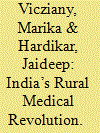

|
|
|
|
|
| Summary/Abstract |
This article explores the potential conflict between allopathic (‘Western’) medicine and rural beliefs in village goddesses, given that each demands blood for diagnostic purposes and sacrifices, respectively. Our objective is to understand the experiences and attitudes of rural residents to blood tests, blood donations and blood transfusions. We explore the specific question of the extent to which poor villagers in Wardha district, Maharashtra, might be supportive of or opposed to point-of-care blood testing at their doorsteps. We began by asking them about their religious practices, including the sacrifice of animals and offerings of blood to deities. Such values could affect their perspectives on human blood and allopathic medicine. After that, we asked whether they had any fears about modern medical treatments and technologies—such fears might be driven by anxieties about angering goddesses if human blood was used for non-sacred purposes. Our investigations took us into an inquiry about villagers’ experiences with hospitals. We came to realise that for villagers, despite the costs of hospital diagnosis and treatment, hospitalisation had become a source of new knowledge about blood. And, finally, we asked villagers what they thought about the value of point-of-care blood testing at their doorstep. We were told that the high cost of hospital treatment means that villagers support technologies that can be used at their doorstep and work towards improving their health and longevity.
|
|
|
|
|
|
|
|
|
|
|
|
|
|
|
|
| 6 |
ID:
182848


|
|
|
|
|
| Summary/Abstract |
The city of Hyderabad has had a distinct linguistic and political history. It was a multilingual city with Urdu (and Persian) as the court languages under the Asaf Jahi dynasty until 1948, when it was annexed by the Indian union. While Hyderabad continues to be multilingual with Telugu, Urdu, Marathi, Kannada and Tamil being spoken in the city, its identity has undergone many changes. It became the Telugu capital city with the formation of Andhra Pradesh state in 1956. In 2014, it became the capital of the newly-formed Telangana state and Urdu was added to Telugu as the official language of the state in 2017. This article examines the transforming image of the city as constructed by Urdu, Telugu and Deccani language films from the 1950s to the present. Reading these films for the discourse on the city, it argues that each addressed its own imagined audience, claimed a specific identity for the city and invisiblised all others. The schism of representation reflected in the films is rooted in the city’s historical past and its multiple contested identities.
|
|
|
|
|
|
|
|
|
|
|
|
|
|
|
|
| 7 |
ID:
182851
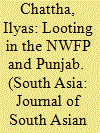

|
|
|
|
|
| Summary/Abstract |
According to Police Special Branch intelligence reports, amidst the chaos of Partition, over 60,000 ounces of gold were stolen from fleeing Hindus and Sikhs in 1947. Alongside political identity and religious organisation and territorialisation, desire for wealth or property was a key trigger for the continuation of the Partition violence. This article documents organised communal violence which erupted in the NWFP and Punjab during 1946–47 using largely underutilised police and intelligence reports from the period. The empirical focus of the article is two-fold. First, to show that the intercommunity violence triggered in these provinces was organised and funded by the Muslim League through its volunteer wings, even if specific perpetrators were locals. Second, that looting was a feature of locally-rooted violence to acquire property owned by non-Muslim minorities. As well, individual motives for revenge or a desire to best one’s business rival fuelled the violence alongside ideological imperatives such as the commitment to the idea of Pakistan.
|
|
|
|
|
|
|
|
|
|
|
|
|
|
|
|
| 8 |
ID:
182853


|
|
|
|
|
| Summary/Abstract |
The disease burden in South Asia is complex and multifaceted: old, new, re-emerging and newly recognised conditions all coexist and interact in ways that we have yet to fully understand. The characteristics of COVID-19 have stressed these comorbidities. A discussion on longevity and the theory of epidemiological transition is followed by an analysis of the Indian experience with infectious and non-infectious diseases, injuries and inflammatory conditions, as an illustration of what has been happening in South Asia more generally. These conditions are not hermetically sealed from each other with comorbidities frequently the cause of death even if the official data does not reveal this. In the final part of this essay, the significance of the research findings in the other five papers that comprise this collection are discussed: these deal with the role of hospitals, new diagnostic and drug technologies and the question of ‘elite capture’ as an explanation for the high cost of medical care for the poor. The collection presents case studies from India, Pakistan and Bangladesh. Our collective approach has been to see the disease burden and health-care responses through a political economy of death and disease, and to link that with insights from ethnographic research and case studies.
|
|
|
|
|
|
|
|
|
|
|
|
|
|
|
|
| 9 |
ID:
182857
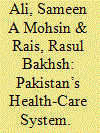

|
|
|
|
|
| Summary/Abstract |
Pakistan currently ranks 154 out of 189 countries on the UNDP’s Human Development Index. In this paper, we use a ‘political settlements analysis’ to understand how the distribution of political, economic and social power explains this ranking and the inequity in Pakistan’s health system. We investigate elite power struggles over the last seven decades to explain how ad hoc policy-making, instability, patronage politics and rent-seeking have led to a maldistribution of resources, lack of oversight, and inequitable access and service provision for a burgeoning population. We argue that these factors have had two consequences: the privatisation of health care, and the opening up of a considerable sphere of influence to the donor community to direct state policy. Despite promising ongoing reform efforts, we conclude that Pakistan’s health system will remain hamstrung by the constraints of a political settlement in which elites with short-term horizons bargain for influence rather than developing an inclusive, consensus-based approach to improving governance outcomes for citizens.
|
|
|
|
|
|
|
|
|
|
|
|
|
|
|
|
| 10 |
ID:
182849


|
|
|
|
|
| Summary/Abstract |
This paper is interested in an emerging canon of post-millennial Indian dystopian fiction in English and the related themes of precarity and (im)purity. After introducing some recent novels and texts from the domestic Indian literary scene, the paper looks to demonstrate how precarity, (im)purity and changing ideas of India(nness) are manifested in Prayaag Akbar’s Leila, a 2017 Indian post-millennial dystopian novel in English. To focus on these particular themes, I consider the novel’s urban geography in terms of its modes of segregation, specifically how the walled sectors of the dystopian, near-future metropolis divide a city ruled over by the Repeaters and pervasive surveillance systems, whilst the Slums and the Outroads lie beyond the city limits. This focus on (im)pure involves an examination of representations of class, privilege, freedom of movement and religious affiliation. Overall, this paper is especially interested in how the dystopian as a narrative mode is harnessed in order to recount ‘precarious’ urban existence, a theme that runs through the wider body of post-millennial Indian dystopian fiction. Through discussion of the (im)purity trope and particularly through the narrative mode of the dystopian, I argue that Leila, like other recent Indian works of this genre, tangentially engages with certain socio-political themes of the second decade of the millennium such as segregation and develops ideas of India(nness) in relation to the Indian post-millennial contemporary.
|
|
|
|
|
|
|
|
|
|
|
|
|
|
|
|
| 11 |
ID:
182850
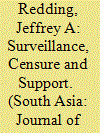

|
|
|
|
|
| Summary/Abstract |
Gender counting has been a longstanding concern of South Asian politics. For the past several years, gender counting has taken on central importance in South Asia in a new register. In both Pakistan and India, as part of a larger discussion on transgender rights and welfare, the state has engaged in various efforts to count the number of transgender persons living within its borders. In this recent (trans)gender counting, we see not only progressive welfare ambitions, but also the resurgence of regressive attitudes and practices towards transgender individuals, the transgender community and kinship practices.
|
|
|
|
|
|
|
|
|
|
|
|
|
|
|
|
|
|
|
|
|